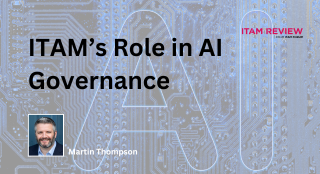SaaS Management is Exploding: Three Reasons Why
In this guest article, Uri Haramati, the co-founder and CEO of Torii, explores the explosion of SaaS/cloud in the last decade and how IT asset managers are using SaaS Management platforms to take back control.
If you want to hear more from Torii, tune into our recent webinar about the challenges of shadow IT, where Chris Shakarian, VP of Marketing at Torii discussed how SaaS Management can reconcile these competing demands.
Five years ago, companies used an average of 16 cloud applications. Today, that number is 110.
As the number of cloud apps increases across organizations, IT departments lose visibility and control over this function. As a result, when asked how many apps their company currently has, IT managers tend to dramatically underestimate the figure. Often, a company has at least three times more applications than IT thinks.
While IT professionals might not know about all their apps, they know change is in the air. They sense that Shadow IT runs rampant, and that cloud applications are the key culprit. Many are turning to SaaS Management Platforms (SMPs) for help.
Torii’s recent survey of professionals found that only 16% currently have an SMP in place; however, 64% of people from the same group intend to evaluate or purchase an SMP in the next two years.
But why the sudden surge in interest? SaaS adoption has increased year over year for a decade. What has changed?
Here’s why SaaS Management has exploded:
1. The WFH Movement
Before 2020, only 6% of employees in the United States said they work from home (WFH) full-time. In May of 2020, due to the pandemic, that number shot up to 35%. As employees went remote, our tools and workflows changed.
The familiar and comfortable processes no longer worked. They couldn’t rely on in-person communication or on-premise tools. With the shift to remote, teams needed to find cloud-based alternatives. But many companies added tools in a decentralized, ad hoc method.
Often, it was department heads or individual employees making these application decisions. IT was often left out of the loop on rapid digital transformation. Once the dust settled, IT was left reacting and scrambling to figure out which applications were added to the company amidst the chaos of the shift.
Today, many IT professionals are still grappling with the aftershocks of that seismic activity. They are still discovering apps, encountering surprise contract renewals, and reckoning with the bloated SaaS spending.
When asking IT professionals what challenge stemming from the pandemic had the largest impact on the organization’s operations, 41% said SaaS spend visibility and optimization.
2. The Great Resignation
In the past, the ideal scenario for many workers was a series of promotions within the same company. However, the modern career path is rarely so straightforward.
Today, the median tenure is lower than ever before. For example, within the U.S., that number is only 4.1 years. These shortened tenures have become even more pronounced during the pandemic as a record number of workers changed jobs.
This is relevant to IT because they are often tasked with maintaining their organizations’ cyber security, and offboarding poses a significant security threat. For example, an Intermedia study found that 89% of employees could access sensitive corporate applications well after departure.
These security threats are known to IT as well. For example, when asked, 76% of IT professionals consider offboarding a significant security threat, especially the failure to revoke access privileges.
To help deprovision these former employees, IT teams are turning to SaaS Management. Many SMPs provide the capability to automatically deprovision users when they leave the company.
3. The Transformation of IT
The role of IT is changing. Of course, it is happening at a different pace for different industries, but the change is still felt.
Once upon a time, IT was the gatekeeper for new technologies. IT was “command & control.” However, in today’s decentralized and increasingly SaaS-powered world, apps are frequently purchased by end-users – not IT.
However, these end-users don’t understand how these applications relate to the entire organization. They typically adopt an application for a specific purpose and then move on.
This leaves IT in a unique position of reshaping its role related to SaaS – which essentially means reshaping its overall role in the company.
They can (unsuccessfully) try to squash Shadow IT. They can take a hands-off approach and let departments and teams run rampant. Or, they can provide desperately needed insight, support, and critical data about how specific SaaS tools impact a department, cross-team collaboration, and the company as a whole. They can become orchestrators who help everyone maximize the benefits of cloud applications while enabling the security that organizations urgently need.
Those that shift to SaaS Management Platforms choose the latter. They believe SMPs provide the best way to help, optimize, and empower the rest of the organization without changing how people work.
To learn more about how a new approach to Shadow IT can benefit ITAM, users, and the overall business – check out our recent webinar with Torii here.
SaaS Management is only the beginning
SaaS Management Platforms are the answer to the inevitable skyrocketing adoption of SaaS applications and the decentralization of the workforce. The recent events simply accelerated the need for these solutions, but these motions are now unstoppable.
As the market evolves, so will the use of SMPs. More stakeholders at companies – from IT and security teams, to finance, procurement and lines of business – will use them to not just gather critical data, but also to automate essential workflows, like application discovery, onboarding, offboarding and spend management, and spur the actions needed to accelerate business.
Do you use Torii? Leave a review on the ITAM Review Marketplace.
Want to hear more from Torii? Tune into our recent webinar about the challenges of shadow IT, where Chris Shakarian, VP of Marketing at Torii discussed how SaaS Management can reconcile these competing demands.
Can’t find what you’re looking for?
More from ITAM News & Analysis
-
Shaping the Future of ITAM – We Want Your Input
The ITAM Forum is currently running a survey to capture hot topics and pressing challenges facing the ITAM profession. The insights gathered will guide our editorial focus and community content for the year ahead. Early responses ... -
Tesco Sues Broadcom and Computacenter for £100M
What’s going on? UK retailer Tesco says it bought VMware perpetual licences in 2021 with support and upgrade rights running to 2026, plus an option to extend. After Broadcom acquired VMware, Broadcom stopped selling support for ... -
83% of IT Managers Believe their Asset Data is Highly Accurate - Only 35% of the Business Agrees
New and interesting research from WanAware hits at the nub of the disconnect many IT Asset Managers might feel about the value they deliver. The ‘Closing the ITAM Confidence Gap. 2025 Survey Insights for IT Leaders’ ...
Podcast
ITAM training
Similar Posts
-
The M&S Cyberattack: How IT Asset Management Can Make or Break Your Recovery
Marks & Spencer (M&S), the iconic UK retailer, recently became the latest high-profile victim of a devastating cyberattack. Fellow retailers The Co-Op and Harrods were also attacked. Recent reports suggest the rapid action at the Co-Op ... -
AI in ITAM: Insightful Signals from the Front Line
During our Wisdom Unplugged USA event in New York in March 2025, we engaged ITAM professionals with three targeted polling questions to uncover their current thinking on Artificial Intelligence—what concerns them, where they see opportunity, and ... -
How ISO/IEC 19770-1 Can Help Meet FFIEC Requirements
In the world of ITAM, the regulatory spotlight continues to intensify, especially for financial institutions facing increasing scrutiny from regulatory bodies due to the growing importance of IT in operational resilience, service delivery, and risk management. ... -
An Introduction to Scope 4 Emissions
Executive Summary For ITAM teams, sustainability is a core responsibility and opportunity. Managing hardware, software, and cloud resources now comes with the ability to track, reduce, and report carbon emissions. Understanding emission scopes—from direct operational emissions ...





